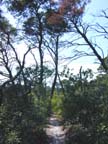| Glossary |
| Photo Gallery |
| About this site |
![]()
 |
| Map showing location of Jonathan Dickinson State Park. |
Jonathan Dickinson State Park consists of over 11,000 acres. The park opened to the public in 1950. It contains sand pine scrub, pinelands, mangroves, river swamps and the Loxahatchee River, Florida's only wild and scenic river. Many endangered or threatened animal species such as the bald eagle, Florida scrub-jay, Florida sandhill crane and gopher tortoise are found here as well.
Jonathan Dickinson State Park offers four nature trails, a bicycle trail, canoeing, picnicking, camping, fishing and guided tours of the Loxahatchee River. For more information, please visit the Jonathan Dickinson State Park website.
There are 13 plant communities in Jonathan Dickinson State Park. About 20% of the park is covered in a rare community of coastal sand pine scrub. Walk along the Sand Pine Nature Trail with us and see the rare coastal sand pine scrub community for yourself.
| A photo gallery is available for this page. |
 [larger image] |
Entrance to Sand Pine Nature Trail |
| Near the beginning of the Sand Pine Nature Trail, sand pines are the predominant trees in the scrub. Through the empty branches of these dead sand pines, needles of live sand pine can be seen. Sand pines have short, twisted needles and highly divided branches. |
![]() IPIX - Sand Pine Scrub
IPIX - Sand Pine Scrub
![]()
Navigate this 360° view of sand pine scrub found along the Sand Pine Nature Trail of Jonathan Dickinson State Park. The most predominant tree within the scrub is the sand pine. Sand pines have short, twisted needles and highly divided branches. Sand pine rarely reaches 100 years in age.

Note: You will need the free IPIX viewer to view this 360° image
Generally, scrubs are communities dominated by pinewoods with an understory of oaks and saw palmetto, occupying well-drained, nutrient-poor, sandy soils. Plants that grow here have adapted to dry conditions. Fires play an important role in the life of scrubs. In the absence of fires, a hardwood forest of oak will develop.
| Insects, disease and fire can kill or reduce the growth of sand pine. The pines pictured here may have been victims of a fire, as a short distance southwest of here we saw a large area containing burned trunks and dead trees. The bark of a mature sand pine is thin, thus it is susceptible to hot fires. | |
 [larger image] |
Looking through the canopy of the sand pine scrub into an open area containing blackened trees and standing dead tree trunks. Although fire can kill mature sand pine, fire is needed to release seeds from cones. |
 [larger image] |
Close-up of blackened trees and standing dead tree trunks found in an open area produced by fire. |
| Watch out for those spikes! |  [larger image] |
| A prickly pear cactus and bloom. Prickly pear has fleshy, flattened pads covered with clusters of fine sharp spikes. In Florida, its flowers generally blossom in all but the winter months. The flowers produce red fruits, which are edible after carefully removing the spikes. | |
| Prickly pear is commonly found in sandy clearings, scrubs and pinelands throughout Florida. It is Florida's most widespread and abundant native cactus. | |
| Saw Palmetto | ||
 [larger image] |
Along the Sand Pine Nature Trail , saw palmetto is the most predominant plant growing in the understory of the sand pine scrub. The fan-shaped leaves of these shrubs have saw-like teeth, hence these palms common name. Opossums and raccoons eat the black, juicy fruits of this plant. Early Indians ate them too. |  [larger image] |
| The saw palmetto is commonly found in pinelands, sandy prairies and sand dunes throughout Florida. | ||
Related SOFIA Information
Below we have listed science projects and publications for studies that are being conducted, or have been conducted, in the area of Jonathan Dickinson State Park. Follow these links to read about each project and to see project-related publications and data.
Science Projects:
- Abnormal Groundwater Conditions and Network Redesign Project
- Aquatic Cycling of Mercury in the Everglades
- Canal and Wetland Flow/Transport Interaction
- Color Infrared Digital Orthophoto Quadrangles for the South Florida Ecosystem
- Compilation of Alligator Data Sets in South Florida for Restoration Needs
- Cycling and Speciation of Mercury in the Food Chain of South Florida
- Ecosystem History: Terrestrial and Fresh-water Ecosystems of southern Florida
- Geochemical Processes in Organic-rich Sediments of South Florida - Mercury and Metals
- Ground Water Cooperative Program
- Groundwater-Surface Water Interactions and Relation to Water Quality in the Everglades
- Interagency Synthesis of Scientific Information, South Florida
- A Retrospective and Critical Review of Aquifer Storage and Recovery Sites in South Florida
- South Florida Information Access
- Southern Inland and Coastal Systems (SICS) Model Development
- Surface Water Cooperative Program
- Vegetative Resistance to Flow in the Everglades
Related Publications:
- Delineation of saltwater intrusion in the surficial aquifer system in eastern Palm Beach, Martin, and St. Lucie Counties, Florida, 1997-98 (from the Water Resources of Florida website)
- Estimation of Infiltration Rates of Saturated Soils at Selected Sites in the Caloosahatchee River Basin (from the Water Resources of Florida website)
- The Florida Everglades
- Geologic Map of the State of Florida
- A GIS Interface for Environmental System Analysis: Application to the South Florida Ecosystem
- Hydrogeology of the Gray Limestone Aquifer in Southern Florida (from the Water Resources of Florida website)
- Relations of a Heterozoan Carbonate-Particle Association to Aquifer Characteristics in a Pliocene Mixed Siliciclastic-Carbonate Ramp (Tamiami Formation), Southern Florida
- South Florida Ecosystem Program
- The South Florida Environment: A Region Under Stress
- USGS Science for Restoration of South Florida: The South Florida Ecosystem Program
- U.S. Geological Survey Program on the South Florida Ecosystem: 2000 Proceedings
- U.S. Geological Survey Program on the South Florida Ecosystem Proceedings of the South Florida Restoration Science Forum
- Water Quality in Southern Florida (from the Water Resources of the United States website)
- Water Resources of Southeastern Florida
